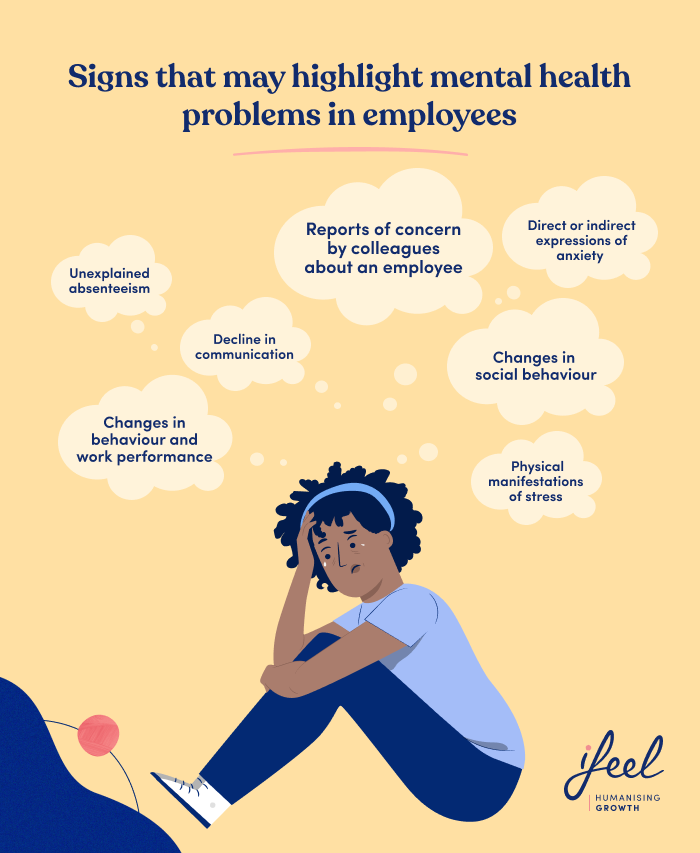How can we spot mental health issues at work? In a world increasingly focused on mental well-being, companies have sought to implement strategies that ensure employees’ well-being to ensure the success and performance of their organisations. However, how do we know which strategies are the most appropriate to carry out?
In this sense, it is essential to detect mental health problems in employees at an early stage and to develop strategies focused on the specific problems of each team. Therefore, detecting mental health problems has become a priority for human resources departments and corporate leadership.

What are the benefits of detecting mental health problems in employees?
Many companies want to prevent the pitfalls and difficulties of mental ill-health, but few take the time to carry out a thorough assessment of each employee’s condition to find out what problems are affecting them so that they can be addressed in time.
An employee’s mental well-being and effective management are closely linked. Therefore, as human resources leaders can take preventive measures to promote well-being and communication in teams, they are also responsible for observing and identifying the signs that may indicate a problem, before they reach a critical point.

In this way, being able to spot mental health issues at work in time brings multiple benefits to the organisation, such as:
1. Mental well-being is a strategic asset
Beyond the ethical value of taking care of mental health at work, it is also a strategic asset for any company. Employees with good mental health are more productive, creative, and committed. They also tend to have higher retention and contribute to a positive work environment. In contrast, unaddressed mental health problems can lead to decreased productivity, increased absenteeism, and a toxic work environment.
2. Long-term cost reduction
Being able to spot mental health issues at work can help avoid significant costs for the company in the long run. For this reason, investing in mental well-being solutions and fostering a healthy work environment can prevent serious and costly problems such as burnout, chronic stress, and long-term sick leave.
3. Improves the dynamics between leaders and employees
Leaders and managers play a crucial role in detecting and addressing mental health issues in their teams. Understanding this can encourage open communication, foster empathy, and conduct mental health training to help employees feel comfortable seeking support. Leaders can also set a positive example by balancing their own mental health and work.
4. Promotes a culture of well-being
To promote a culture of well-being, it is important to spot mental health issues at work. By responding to the mental health needs of employees, this fosters an environment of openness, where employees feel listened to and safe, knowing that they have resources to promote self-reflection and talk about their mental health challenges.
5. Quantifiable business benefits
In addition to improving individual quality of life, investing in an employee engagement platform can also provide tangible business benefits. These include increased customer satisfaction, productivity, employee retention and improved corporate reputation.
How to spot mental health issues at work
Having established the importance of detecting mental health problems at work, it is essential to recognise what kinds of signs to look out for, so that support can be provided before challenges escalate. Here are some ways in which leaders, managers, and HR can recognise these problems by taking note of the following signs:
- Changes in behaviour and work performance: Paying attention to significant changes in an employee’s behaviour and performance can be a key indicator when learning to spot mental health issues at work. This may include decreased productivity, lack of concentration, frequent procrastination, increased absenteeism or presenteeism (being physically present but not engaged at work), and changes in social interaction.
- Poor communication or changes in communication: Observe if an employee exhibits poor communication, such as more curt responses, avoidance of meetings or emails, or a noticeable withdrawal from team communication, as this may represent a sign of problems in their level of mental well-being.
- Changes in social behaviour: Paying attention to changes in social behaviour inside and outside the workplace can help leaders detect whether there is a problem with the mental health of their workforce. For example, an employee who was previously very sociable and who, after a period of time, changed their behavioural pattern to a more withdrawn one, may indicate that something is going on. It is relevant to inquire about this. Similarly, introverted people may become even more withdrawn, or, conversely, begin to exhibit more extroverted or exaggerated behaviour.
Such sudden changes are often indicative of changes in lifestyle, or current circumstances, and it is important to inquire about this to rule out that the change is due to a deterioration in mental health or to prevent the situation from worsening.
- Physical manifestations of stress: the body often expresses what words do not, so it is not uncommon to find that mental health problems can manifest themselves physically. Watching for signs of chronic stress, such as changes in weight, sleep problems, constant fatigue, or unexplained physical aches and pains, can indicate underlying concerns.
- Direct or indirect expressions: Some employees may express mental health concerns directly, while others may do so more indirectly or through jokes, comments, or social media posts that suggest anxiety, stress or discouragement. As such, it is crucial not to overlook such comments, and to provide appropriate solutions.
- Performance reviews and feedback: Performance reviews and regular feedback conversations can be a good time to spot mental health issues at work. It is, therefore, essential to listen carefully to the employee’s concerns during these interactions and to provide an empathetic and friendly environment in which the individual can feel safe and non-judgmental.
- Unexplained absenteeism: When an employee begins to miss work for no apparent reason or experiences a series of unscheduled absences, it may indicate mental health problems, and questions should be asked to provide support if necessary.
- Colleague reporting: Colleagues can often spot mental health issues at work. For this reason, it is essential to foster a culture of support and open communication that can lead to colleagues reporting legitimate concerns about a colleague.
By recognising these signs and symptoms, leaders and HR professionals can take proactive steps to support employees in managing their mental health problems. These actions may include offering an employee assistance program (EAP), providing sick leave, offering support, or adjusting job responsibilities temporarily to reduce workload. Early detection and appropriate response are critical to keeping employees healthy, engaged and productive.

Join the global leading solution in mental well-being
Ways to spot mental health issues at work: Prevention is key
Ifeel is a mental well-being solution for companies, designed by its team of psychologists with the aim of helping companies boost the work commitment of their employees and increase productivity.
Thanks to this collaboration, human resources managers can receive personalised, data-based advice on the most effective measures for detecting mental health problems in employees and measuring the working climate of their teams. This is the best way to understand their needs.
Moreover, ifeel’s mental well-being solution for companies offers employees a mental health care service structured at different levels depending on their needs at any given time. This means they can access various mental health care tools via ifeel’s app. On a second level, they can receive emotional support through a chat with one of the psychologists on our platform. If they prefer more continuous support over time, they only need to access the third level of the programme: online psychological therapy with a psychologist specialised in cases like theirs.
We hope you found this article on how to spot mental health issues at work useful. If you would like more information about our mental well-being solution for companies, simply request it, and we will contact your team as soon as possible.









